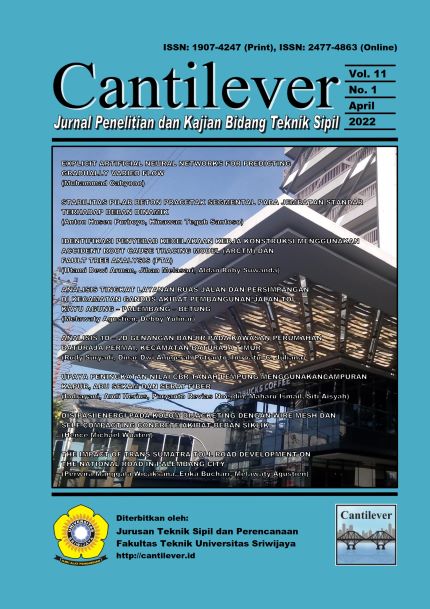Identifikasi Penyebab Kecelakaan Kerja Konstruksi Menggunakan Accident Root Cause Tracing Model (ARCTM) dan Fault Tree Analysis (FTA) Identification of Causal Factors on Construction Accidents Using Accident Root Cause Tracing Model (ARCTM) and Fault Tree Analysis (FTA)
Main Article Content
Abstract
The construction sector greatly contributed to the increase in the number of injuries and even deaths of workers. This study aims to identify unsafe conditions and unsafe acts and to analyze the causes of work accidents on the Talago Embung Project in the village of Sikabu kabu, Luhak, District of Limo Puluh Kota by using the Accident Root Cause Tracing Model (ARCTM) and Fault Tree Analysis (FTA). Data were collected through observation, in-depth interviews, and documentation. The causes of construction accidents identified are as follows; a) environmental factors i.e. weather or climate, lack of lighting, b) tools and facilities factors i.e. equipment life cycle, availability of Personnel Protective Equipment (PPE), and negligence in maintaining it, c) human factors i.e. personal issues, work pressure, and physical condition of workers, lack of skills and experience of workers, and d) management factors i.e. ineffective communication between the management team and workers and among workers, inadequate SOP and inappropriate material layout planning. Based on the results, it is expected that there will be training directly related to tasks and work safety, adequate project layout planning, proper supervision, and adequate maintenance of work safety equipment.
Downloads
Article Details
Alim, Syawaluddin,. Adwitya Bhaskara (2020). Analisis Kausalitas Kecelakaan Konstruksi Berdasarkan Penilaian Kontraktor dengan Fault Tree Analysis (FTA) Studi Kasus: Proyek Pembangunan Underpass Kentungan. Diss. University Technology Yogyakarta, 2020.
Endroyo, Bambang, and Tugino Tugino (2009). Analisis Faktor-faktor Penyebab Kecelakaan Kerja Konstruksi. Jurnal Teknik Sipil dan Perencanaan 9. pp-21.
Gita, Mira Anjar (2015). Analisa Risiko Kecelakaan Kerja Proyek Marvell City Linden Tower Surabaya Menggunakan Metode FMEA (Failure Mode And Effect Analysis) Dan FTA (Fault Tree Analysis). Diss. Institut Teknology Sepuluh Nopember.
Herawan, Asep Beni. (2019). Spesifikasi Teknis Embung Talago Kabupaten Lima Puluh Kota.
Pasaribu, Haryanto Pandapotan, Harijanto Setiawan, dan Wulfram I. Ervianto. (2017). Metode Failure Mode and Effect Analysis (FMEA) dan Fault Tree Analysis (FTA) Untuk Mengidentifikasi Potensi dan Penyebab Kecelakaan Kerja pada Proyek Gedung." Atma Jaya Yogyakarta.
Primadianto, Digma., Sandra Karisma Putri, dan Ratna S. Alifen (2018). Pengaruh tindakan tidak aman (unsafe act) dan kondisi tidak aman (unsafe condition) Terhadap Kecelakaan Kerja konstruksi." Jurnal Dimensi Pratama Teknik Sipil 7.1 pp 77-84.
Rizky, Reyhan Ikhsanul (2003). Analisis Faktor Penyebab Kecelakaan Kerja Proyek Konstruksi GKM Tower Jakarta Selatan Menggunakan Metode Fault Tree Analysis (FTA) dan Manajemen Pencegahan serta Penanganannya." Scientific Article. Bandung: Faculty of Civil and Environmental Engineering, Institut Teknologi Bandung.
Suraji, Akhmad. A. Roy Duff ; Stephen J. Peckitt. (2001). Development of Causal Model of Construction Accident Causation, Journal of Construction Engineering and Management, July-August 2001 pp. 343.

This work is licensed under a Creative Commons Attribution-NonCommercial 4.0 International License.
Authors who publish with this journal agree to the following terms:
- Authors retain copyright and grant the journal right of first publication with the work simultaneously licensed under a Creative Commons Attribution-NonCommercial 4.0 International License that allows others to share the work with an acknowledgment of the work's authorship and initial publication in this journal.
- Authors are able to enter into separate, additional contractual arrangements for the non-exclusive distribution of the journal's published version of the work (e.g., post it to an institutional repository or publish it in a book), with an acknowledgment of its initial publication in this journal.
- Authors are permitted and encouraged to post their work online (e.g., in institutional repositories or on their website) prior to and during the submission process, as it can lead to productive exchanges, as well as earlier and greater citation of published work (See The Effect of Open Access).
